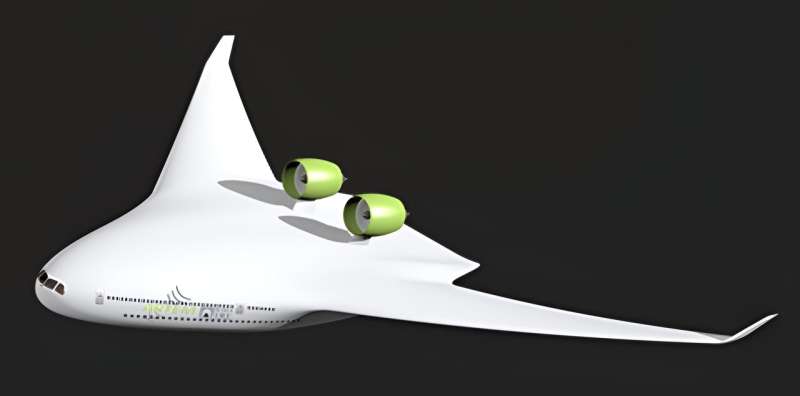This article has been reviewed according to Science X's editorial process and policies. Editors have highlighted the following attributes while ensuring the content's credibility:
fact-checked
trusted source
proofread
Psycho-acoustic simulations: Virtual noise assessment for passenger jet of the future

Aircraft noise is often a nuisance for people living near airports and in flight paths—and, in the worst case, a health hazard, from sleep disorders to cardiovascular diseases. According to a report by the European Environment Agency, about 4 million people in Europe were exposed to excessive levels of aircraft noise in 2017.
New types of aircraft with a blended wing body (BWB), whose fuselage merges seamlessly into the wings—with less air resistance and lower fuel consumption—are seen as a beacon of hope to alleviate this burden. They also project lower noise emissions toward the ground if the engines are mounted on top of the fuselage.
Auralization in the lab
Although the noise emissions of such aircraft can be estimated using simulation tools, their disturbing and stressful effect on people can only be realistically recorded by taking into account the subjective perception of those affected. Acoustics experts at Empa have been successfully pursuing the approach of so-called auralization for auditory impressions for years, analogous to visualization for the eye—for example, to investigate the effects of railroad noise on people.
Reto Pieren, Axel Heusser and Beat Schäffer from Empa's Laboratory for Acoustics / Noise Control also used this expertise in the European project ARTEM (Aircraft Noise Reduction Technologies and related Environmental iMpact), in which numerous partners developed concepts for low-noise long-haul aircraft—with a specially designed BWB and different engine variants.
The consortium also considered other noise reduction technologies such as a trailing edge with optimized "Krüger flaps" or modern geared turbofan engines with a large ratio of the airflow outside the combustion chamber to the airflow of the hot exhaust jet, which significantly reduces noise.
Noise simulations: Purely mathematical
How would such new long-haul aircraft for about 400 passengers perform compared to conventional aircraft? The Empa team has now published its results in the journal Aerospace Science and Technology. Based on the laws of physics, the experts generated noise simulations of overflights—purely synthetically using computer programs.
They checked these simulations against recordings of current aircraft arrivals and departures around Zurich Airport. As the simulated noise corresponded well with the measured data, they could be used for comparison with the simulations for the new BWB aircraft concept.
In order to determine how disturbing the noise emissions of the various commercial aircraft are to people when they fly over, 31 people aged between 18 and 61 took part in elaborately designed experiments in Empa's AuraLab. The spatial simulations from the precisely arranged loudspeakers constituted—after a familiarization run—36 overflights: Take-offs and landings of conventional and innovative aircraft types, each in different flight phases. These noise scenarios also included details such as flap positions or the position of the landing gear as well as atmospheric conditions such as turbulence or sound reflections on the ground.
After the experiment, the test subjects filled out questionnaires, in which they reported their subjective impressions—using a common and standardized 11-point scale ranging from 0 for "not at all disturbed or annoyed" to 10 for "extremely disturbed or annoyed." They were also asked how familiar the respective sound event sounded to them.
Significantly lower annoyance
The results: The new BWB aircraft was rated 4.3 units less noisy at best than the conventional passenger jet. This is a clear difference, which was also due to the fact that the virtual aircraft in the simulation was equipped with additional noise reduction technologies or particularly low-emission engines. In addition, the surveys showed that take-offs of this type of aircraft left a sound impression that seemed less familiar to the participants—an indication of unusual acoustic characteristics that are likely to have a positive influence on the perception of annoyance.
Of course, it is difficult to predict which variant of a BWB aircraft will prevail in the future, given the many possible variants. But according to Empa researcher Reto Pieren, one thing is certain. "The greatest contribution to noise reduction undoubtedly comes from the shape of the aircraft, which shields the engine noise downwards," says the acoustics expert, "other noise reduction technologies only account for around 15% of the reduction in annoyance."
More information: Reto Pieren et al, Perception-based noise assessment of a future blended wing body aircraft concept using synthesized flyovers in an acoustic VR environment—The ARTEM study, Aerospace Science and Technology (2023). DOI: 10.1016/j.ast.2023.108767



















